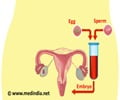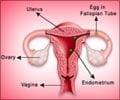Sperm have only one objective: to find the egg and the egg supports sperm in their hunt by emitting attractants that induce changes in the calcium level inside sperm, researchers say.

Together with colleagues from the Max Planck Institute for the Physics of Complex Systems in Dresden and the University of Gottingen, scientists from the Caesar Research Center in Bonn, an institute of the Max Planck Society, have discovered that sperm only react to changes in calcium concentration but not to the calcium concentration itself.
Probably sperm make this calculation so that they remain capable of manoeuvring even in the presence of high calcium concentrations.
The swimming path on which sperm follow the mating call of the egg, varies according to species.
Sperm - in particular those of marine species - swim along convoluted paths in a chemical concentration gradient.
Their swimming style is controlled by the calcium ions in the sperm tail.
It was previously believed that at high calcium concentration, the sperm tails make asymmetrical, whip-like movements and their swimming path is very curved, while at low calcium concentration, the tail beats symmetrically and sperm swim on a straight line.
The alternation of high and low calcium concentrations was thought to steer sperm along spiral-shaped swimming paths.
However, this simple model was in contradiction with experiments on freely-swimming sperm and presented the investigators with something of a mystery.
The scientists have now succeeded into solving this mystery. Using an ingenious stroboscopic laser illumination - similar to that used in discotheques - the project leader Luis Alvarez was able to trace the movement of sperm in detail, and simultaneously measure the changes in the calcium concentration.
The result was astonishing: the sperm tail only reacted to the time derivative of the calcium concentration and the absolute concentration was of little relevance.
To put it simply: sperm can perform calculus! Exactly how they do this is unclear. The caesar scientists suspect that sperm detect calcium ions with the help of two proteins.
Calcium binds to one protein fast and to the other slow. By comparing the amount of calcium bound on both proteins can compute a "chemical derivative", so to speak.
Sperm carry out this complicated calculation that we first encounter at the upper secondary school level as the concentration of the attractants and, therefore also, the calcium concentration in sperm is very high near the egg.
The mathematical trick probably enables sperm to be able to react even in the presence of such high calcium concentrations.
Source-ANI











